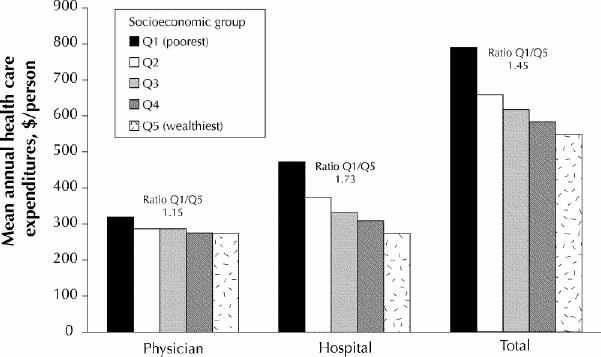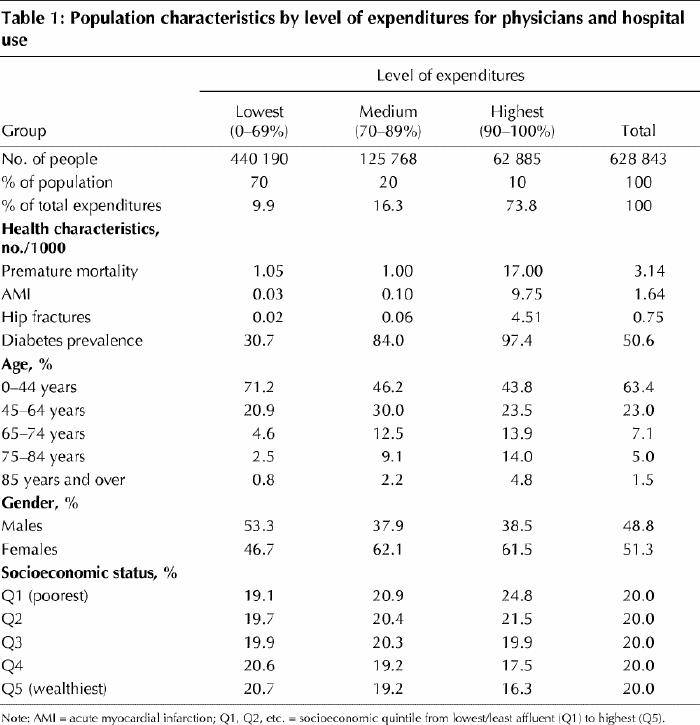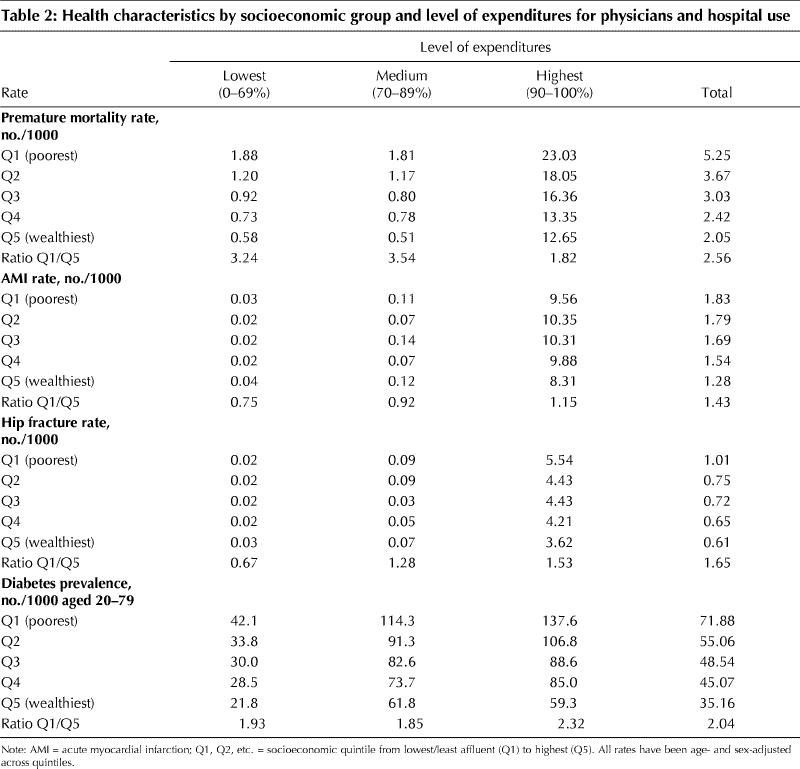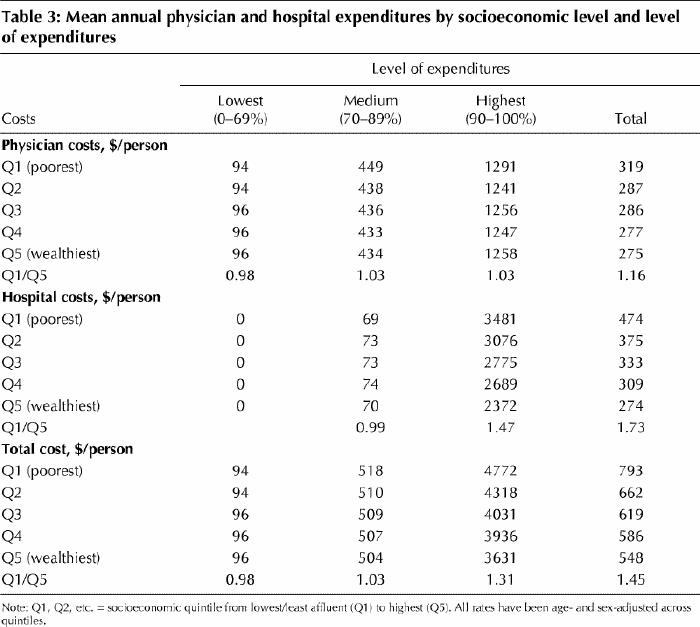Abstract
Background
Many argue that “free” medical care leads to unnecessary use of health resources. Evidence suggests that user fees do discourage physician use, at least by those of low socioeconomic status. In this study, we compare health care utilization and health among socioeconomic groups to determine whether people of low socioeconomic status see physicians more than would be expected given their health status.
Methods
We examined the use of health care services (physicians and hospitals) by residents of Winnipeg, Manitoba, in 1999. The cost of physician services was drawn directly from the claims filed, and the cost of hospital services was estimated using the Case Mix Group and Day Procedure Group methods linked to resource intensity weights and Manitoba hospital costs. We used neighbourhood indicators of socioeconomic status from the 1996 census and measured health status by examining rates of premature mortality, acute myocardial infarction, hip fracture (1995–1999) and diabetes (1999). Using these measures, we compared health status and health care use of residents living in areas with low average household incomes with those living in areas with high average household incomes. All rates were age- and sex-adjusted across the groups.
Results
The province spent 44% more providing hospital and physician services to residents of Winnipeg neighbourhoods with the lowest household incomes ($820/person annually v. $596/person for residents of the neighbourhoods with highest household incomes). However, expenditures were strongly related to health status. The 70% of the population on which the province spends 10% of its health care dollars scored well on all health indicators, and the 10% of the population on which 74% of the dollars are spent scored poorly. In each expenditure group, those with lower socioeconomic status had poorer health. In the highest expenditure group, those with lowest socioeconomic status had 82% higher premature mortality rates (23.0 v. 12.6 per 100 000 population) and 53% higher hip fracture rates (5.5 v. 3.6 per 100 000 population) than those with the highest socioeconomic status. Despite their poorer health, in each expenditure group, residents of the neighbourhoods with the lowest household incomes incurred physician expenditures that were similar to those of residents of wealthier neighbourhoods.
Interpretation
Most people use little health care; high-cost users are a small group of very sick people drawn from all neighbourhoods and all income groups. People living in areas with low average household incomes use fewer physician services than might be expected, despite their poor health status.
Many have argued that escalating health care costs in Canada are exacerbated by the fact that patients face no costs when they visit doctors or use hospital services. A zero price, it is said, leads to unnecessary use of the system.1,2,3,4,5,6
Various policies focusing on reducing patient demand have been proposed to address this purported overuse — user fees and medical savings accounts being the 2 most popular. All are supposed to work by creating an incentive for people to decide whether their intended use of the health care system is really necessary. We know that user fees are effective in reducing physician visits by those with low economic status, but have little impact on physician use by the more affluent or on hospital use.7,8
Is there any evidence that a universal health care system encourages the less affluent to see physicians more often than necessary? We have already shown that the great majority of people incur few health care expenditures while a small group incurs high expenditures.9 This report extends our earlier work by first examining the health and socioeconomic characteristics of those in each expenditure group. We then assess whether residents of low-income areas overuse health care services (particularly physicians) relative to their health status.
Methods
This paper focuses on the population of Winnipeg, Manitoba. Total physician costs incurred by Winnipeg residents were calculated by summing all physician billings for office, hospital and emergency department visits as well as costs associated with laboratory tests, radiologic exams and surgical fees. Hospital costs were estimated using the Case Mix Group and Day Procedure Group methods, linked to resource intensity weights10 and Manitoba hospital costs using a method previously described.11 The hospital and physician data have been found to be reliable for research purposes.12,13,14
Winnipeg residents (excluding residents of nursing homes) were ranked according to the total amount the Manitoba government spent providing each with hospital and physician services in 1999–2000. The 10% of the population with the highest expenditures were identified as the highest use group; the next 20% as the medium use group; and the bottom 70% as the lowest use group. These divisions emerged naturally from the data. The lowest use group had virtually no hospital expenditures and few physician expenditures, whereas the highest use group had significant hospital expenditures.
Residents of Winnipeg (again excluding nursing home residents) were also divided into 5 income groups using data on mean neighbourhood household income from the 1996 Canadian census public use database.
We gathered data on the rates of death among those aged 0–74 years, the so-called premature mortality rate, because it is recognized as the “single best proxy for reflecting differences in the health status of... populations.”15,16 All types of deaths are included in this measure. We chose hip fractures and acute myocardial infarctions (AMIs) as additional health indicators. Wennberg and colleagues17,18 suggest these are also good measures of population morbidity. People with diabetes were identified as those aged 20–79 years having 1 or more physician contacts or hospitalizations during which this diagnosis was recorded over the 3-year period (1997–1999).19 Diabetes is one of the most rapidly increasing chronic diseases, the prevalence of which can be accurately measured using administrative data. All rates were age- and sex- adjusted using the direct method, with the population of Winnipeg taken as the standard.
To ensure stability, 5 years' data (1995–1999 divided by 5) were used to calculate annual rates of premature deaths, hip fractures and AMIs. Differences across the expenditure groups and across income groups were tested using 95% confidence intervals. Because the groups are so large, virtually all the differences are statistically significant and are, hence, not indicated in the tables (data available from authors).
Results
On average, 15% more is spent annually providing physician services to residents of the lowest income neighbourhoods than the highest ($319/person vs. $275/person) (Fig. 1). Annual spending on hospital care is 73% higher for residents of neighbourhoods with the lowest average family incomes than for residents of neighbourhoods with the highest family incomes ($474/person versus $273/person). As socioeconomic status decreases, the cost of providing health care increases.

Fig 1: Mean health care expenditures by socioeconomic group. The exact numbers in each quintile group are as follows: Q1 125 783; Q2 125 817; Q3 125 823; Q4 125 808; Q5 125 612. Note: All means have been age- and sex-adjusted across socioeconomic groups.
We listed population and health characteristics according to whether the individual is in the lowest use group (average of $95/person annually in health care expenditures), the medium use group ($510/person) or the highest use group ($4179/person) (Table 1). The 70% of the population in the lowest use group consume only 10% of health care dollars, while the 10% of the population who are the highest users consume 74% of the dollars.
Table 1

The highest expenditure group has by far the poorest health, i.e., the highest premature mortality, AMI and hip fracture rates. The medium expenditure group has a high rate of diabetes — more than twice that of the lowest use group.
The large proportion of the population in the low expenditure group is essentially healthy. People in this group typically contact a physician 2 or fewer times a year and undergo associated lab tests. During the year, 882 of the 440 190 people in this low expenditure group died. Their accident–suicide–homicide rate is twice as high as that of the high expenditure group, but these deaths make up a relatively small proportion of the total.
Residents of the poorest neighbourhoods are somewhat overrepresented in the high expenditure group (24.8%) compared with those living in the wealthiest neighbourhoods (16.3%).
In Table 2, health characteristics are reviewed by neighbourhood income quintile for each of the expenditure groups. The data have been age- and sex-adjusted to the Winnipeg population. In each expenditure group, the lower the socioeconomic status, the poorer the health status, except for rate of AMI.
Table 2

Although the data suggest that the health of those with lower socioeconomic status is worse than those of higher status at every level of health care expenditure, there was no pattern of higher physician expenditures on those whose socioeconomic status is lower. Among the 70% of the population with the lowest health care expenditures, mean expenditures on physician services range from $94 a year for residents of the poorest neighbourhoods, to $96 a year for residents of the wealthiest neighbourhoods (Table 3). Even among the 10% of Winnipegers requiring the highest medical expenditures, there is only a 3% difference across socioeconomic groups in what is spent on physician services (from $1258 to $1291). Among the remaining 90% of the population on whom fewer health dollars are spent, there is essentially no difference across the socioeconomic groups in what is spent on physician and hospital services. In the high expenditure group, 47% more is spent on hospital use for residents of the lowest income neighbourhoods ($3481/person annually) compared with what is spent on residents of the highest income neighbourhoods ($2372/person).
Table 3

Interpretation
Most residents of Winnipeg are healthy, infrequent users of physicians and hospitals. Those incurring high health care costs are sick by every measure used. These high-cost users are drawn from every neighbourhood and every socioeconomic group, and their health care expenditures are driven by hospital costs. High-cost users who are residents of low-income neighbourhoods incur more hospital costs. Other research based on review of medical records20,21 has shown the acuity levels of hospitalized patients in the lowest socioeconomic group to be just as high as acuity levels of hospitalized patients in higher socioeconomic groups. Hence the greater use of hospitals by residents of low-income neighbourhoods should not be dismissed as “social admissions”; their high use is consistent with their poorer health status.
Physician visits are the one type of health care use where at least the first visit in any episode is strongly influenced by patient behaviour. The Winnipeg data confirm that physician use by low-income groups is already lower than would be expected given their health status (or physician use by high-income groups is higher than one would expect).
This study has important limitations. Our analysis is based on the use of physician and hospital services by residents of only one Canadian city; however, previous analyses22,23,24,25,26,27 have shown that hospital use patterns across socioeconomic groups in Winnipeg are similar to those in other areas. In a recent cross-Canada report on health and the availability of health care, Winnipeg rated 14th (out of 57 health regions) in terms of physicians per capita and 8th for specialists per capita.28
We also relied on an ecological rather than an individual-based definition of socioeconomic status. However, ongoing work at the Manitoba Centre for Health Policy linking self-reported household income (from the National Population Health Survey) with administrative data on total health care costs consumed over a 2-year period shows similar gradients in expenditure patterns (data available from the authors). It has been shown repeatedly that the ecological measures follow individual measures very closely.29 Ecological measures are also important in their own right, and their use is supported by several analyses using both individual and neighbourhood measures.27,30,31
The patterns of health care costs that we examined are driven by poor health and hospital expenditures. Policies aimed at reducing patient demands, such as user fees and medical savings accounts, are not likely to reduce overall costs. User fees discourage physician contact, not hospital use. Thus, user fees would discourage preventive contacts, particularly among the poor, a group in which pap smears, childhood immunizations and prenatal care are already known to be underutilized.32,33,34 Since the RAND study35 demonstrated that user fees discourage patients from seeking both appropriate and inappropriate care, their effects on even the healthy poor would be pernicious.
Physicians are the gatekeepers to hospitals, and the health status of the patient largely drives the decision to admit and, hence, expenditure patterns. Although higher income patients may be more articulate in asking for high-profile surgical treatments,36,37 overall those with the poorest health status show the highest hospital use and expenditure rates. There is scope for decreasing hospital expenditures by focusing on evidence-based medicine, physician practice patterns and hospital management. However, user fees and medical savings accounts are unlikely to contribute to this process.
As a final observation, the affluent are well represented in the high expenditure group. Thus, “protection” of the universal Canadian health system would appear to be as important and valuable to rich Canadians as to the poor.
Acknowledgments
Funding from the Canadian Population Health Initiative supported this study. The results and conclusions are those of the authors; we are indebted to Health Information Services, Manitoba Health and the Office of Vital Statistics in the Agency of Consumer and Corporate Affairs for providing data. No official endorsement by Manitoba Health or the Office of Vital Statistics is intended or implied. We also thank Wendy Armstrong, Gordon Guyatt, Kip Sullivan and P.J. Devereaux for their thoughtful review of the manuscript and their helpful suggestions.
Footnotes
This article has been peer reviewed.
Contributors: Noralou Roos designed the project and wrote the final draft of this report. Evelyn Forget made a substantial contribution to reconceptualization of the article and preparation of the final draft. Randy Walld and Leonard MacWilliam were involved in the design of the study, data collection and analysis, and drafting of key sections.
Competing interests: None declared.
Correspondence to: Dr. Noralou Roos, Manitoba Centre for Health Policy, University of Manitoba, 408-727 McDermot Ave., Winnipeg MB R3C 3P5; fax 204 789-3910; Noralou_Roos@cpe.umanitoba.ca
References
- 1.Gratzer D. It's time to consider Medical Savings Accounts. CMAJ 2002;167(2):151-2. [PMC free article] [PubMed]
- 2.Ramsay C. Critical Issues Bulletin. Medical savings accounts: universal, accessible, portable, comprehensive health care for Canadians. Vancouver: The Fraser Institute; 1998.
- 3.Coffey EJ, Chaoulli J. Universal private choice: a concept of health care with quality access and choice for all Canadians. Montréal: Montreal Economic Institute; 2000.
- 4.Holle P, Owens D. Universal medical savings accounts: consumerizing medicare to end waiting lists and improve service. Policy series, no 5. Winnipeg: Frontier Centre for Public Policy; 2000.
- 5.Crowley BL, Zitner D, Faraday-Smith N. Operating in the dark: the gathering crisis in Canada's health care system. Halifax: Atlantic Institute for Market Studies; 2002.
- 6.Gratzer D, editor. Better medicine reforming Canadian health care. Toronto: ECW Press; 2002.
- 7.Newhouse JP, Insurance Experiment Group. Free for all? Lessons from the RAND Health Insurance Experiment. Cambridge (MA): Harvard University Press; 1993.
- 8.Beck RG. The effects of co-payment on the poor. J Hum Resour 1974;9(1):129-42.
- 9.Forget EL, Deber R, Roos LL. Medical savings accounts: Will they reduce costs? CMAJ 2002;167(2):143-7. [PMC free article] [PubMed]
- 10.Canadian Institute for Health Information. DAD resource indicators for use with complexity 1999. Ottawa: The Institute; 1999.
- 11.Finlayson G, Roos NP, Jacobs P, Watson D. Using the Manitoba Hospital Management Information System: comparing average cost per weighted case and financial ratios of Manitoba hospitals. The next step [report]. Winnipeg: Manitoba Centre for Health Policy; 2001.
- 12.Roos LL, Sharp SM, Cohen MM. Comparing clinical information with claims data: some similarities and differences. J Clin Epidemiol 1991;44(9):881-8. [DOI] [PubMed]
- 13.Roos LL Jr., Nicol JP, Cageorge SM. Using administrative data for longitudinal research: comparisons with primary data collection. J Chronic Dis 1987;40(1):41-9. [DOI] [PubMed]
- 14.Roos LL, Sharp SM, Wajda A. Assessing data quality: a computerized approach. Soc Sci Med 1989;28(2):175-82. [DOI] [PubMed]
- 15.US General Accounting Office. Public health: a health status indicator for targeting federal aid to states: report to the chairman, Committee on Labor and Human Resources, U.S. Senate. GAO/HEHS-97-13. Washington: The Office; 1996.
- 16.Kindig D. Purchasing population health paying for results. Ann Arbor (MI): University of Michigan Press; 1997.
- 17.Wennberg JE, Freeman JL, Culp WJ. Are hospital services rationed in New Haven or over-utilised in Boston? Lancet 1987;1(8543):1185-9. [DOI] [PubMed]
- 18.Wennberg JE, Cooper MM. Variations, patient need, practice style and hospital capacity. In: The quality of medical care in the United States: a report on the Medicare Program, The Dartmouth Atlas of Health Care in the United States 1999. Chicago: American Hospital Publishing; 1999. [PubMed]
- 19.Robinson JR, Young TK, Roos LL, Gelskey DE. Estimating the burden of disease. Comparing administrative data and self-reports. Med Care 1997;35(9):932-47. [DOI] [PubMed]
- 20.DeCoster C, Roos NP, Carriere KC, Peterson S. Inappropriate hospital use by patients receiving care for medical conditions: targeting utilization review. CMAJ 1997;157(7):889-96. [PMC free article] [PubMed]
- 21.Bruce S, DeCoster C, Trumble Waddell J, Burchill C, De Haney S. Acuity of patients hospitalized for medical conditions at Winnipeg acute care hospitals. Winnipeg: Manitoba Centre for Health Policy and Winnipeg Regional Health Authority; 2001.
- 22.Manga P, Broyles RW, Angus DE. The determinants of hospital utilization under a universal public insurance program in Canada. Med Care 1987; 25(7):658-70. [DOI] [PubMed]
- 23.Siemiatycki J, Richardson L, Pless IB. Equality in medical care under national health insurance in Montreal. N Engl J Med 1980;303(1):10-5. [DOI] [PubMed]
- 24.Haan M, Kaplan GA, Camacho T. Poverty and Health. Prospective evidence from the Alameda County Study. Am J Epidemiol 1987;125(6) 989-98. [DOI] [PubMed]
- 25.Carstairs V, Morris R. 1989. Deprivation: explaining differences in mortality between Scotland and England and Wales. BMJ 1989;299(6704):886-9. [DOI] [PMC free article] [PubMed]
- 26.Pappas G, Queen S, Hadden W, Fisher G. The increasing disparity in mortality between socioeconomic groups in the United States, 1960 and 1986. N Engl J Med 1993;329(2):103-9. Erratum in: N Engl J Med 1993;329(15):1139. [DOI] [PubMed]
- 27.Marmot M. Multilevel approaches to understanding social determinants. In: Berkman LF, Kawachi I, editors. Social epidemiology. London: Oxford University Press; 2000. p. 349-67.
- 28.The top 20 health regions, and how they ranked in each category. Macleans 2003;116:(24)24-6.
- 29.Mustard CA, Derksen S, Berthelot JM, Wolfson M. Assessing ecologic proxies for household income: a comparison of household and neighborhood level income measures in the study of population health status. Health Place 1999;5(2):157-71. [DOI] [PubMed]
- 30.Krieger N. Women and social class: a methodologic study comparing individual, household and census measures as predictors of black/white differences in reproductive history. J Epidemiol Commun Health 1991;45(1):35-42. [DOI] [PMC free article] [PubMed]
- 31.Diez-Roux AV, Nieto FJ, Muntaner C, Tyroler HA, Comstock GW, Shahar E, et al. Neighborhood environments and coronary heart disease: a multilevel analysis. Am J Epidemiol 1997;146(1):48-62. [DOI] [PubMed]
- 32.Roos LL, Traverse D, Turner D. Delivering prevention: the role of public programs in delivering care to high-risk populations. Med Care 1999;37(6 Suppl):JS264-78. [DOI] [PubMed]
- 33.Katz SJ, Hofer TP. Socioeconomic disparities in preventive care persist despite universal coverage. Breast and cervical cancer screening in Ontario and the United States. JAMA 1994;272(7):530-4. [PubMed]
- 34.Mustard CA, Roos NP. The relationship of prenatal care and pregnancy complications to birthweight in Winnipeg, Canada. Am J Public Health 1994;84(9):1450-7. [DOI] [PMC free article] [PubMed]
- 35.Lohr KN, Brook RH, Kamberg CJ, Goldberg GA, Leibowitz A, Keesey J, et al. Use of medical care in the Rand Health Insurance Experiment. Diagnosis- and service-specific analyses in a randomized controlled trial. Med Care 1986;24(9 Suppl):S1-87. [PubMed]
- 36.Carlisle DM, Valdez RB, Shapiro MF, Brook RH. Geographic variation in rates of selected surgical procedures within Los Angeles County. Health Serv Res 1995;30(1):27-42. [PMC free article] [PubMed]
- 37.Frohlich N, Fransoo R, Roos N. Health service use in the Winnipeg Regional Health Authority: variations across areas in relation to health and socioeconomic status. Healthc Manage Forum 2002 Winter;Suppl:9-14. [DOI] [PubMed]


